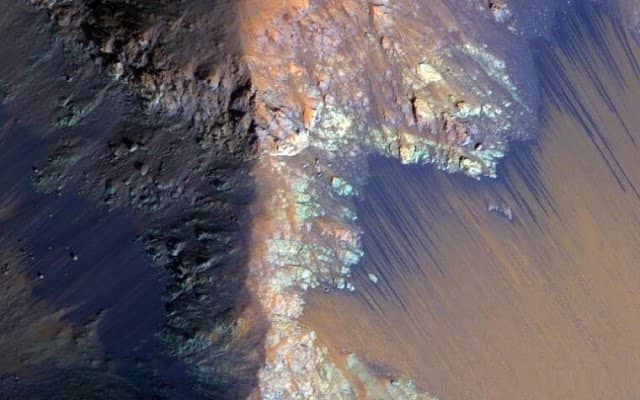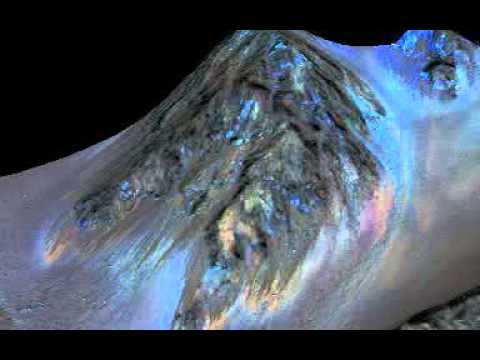NASA Scientists Confirm There is Water On Mars (Video)
NASA Scientists Confirm There is Water On Mars (Video)
New Discoveries on Mars: New Horizons in Space Science
Since humanity launched its first rocket into space, there has been a strong desire to explore distant planets and uncover the secrets of the universe. Mars, known as the “Red Planet,” has always been at the heart of these explorations. As humanity approaches deeper cosmic exploration, speculation about the possibility of life beyond Earth has increased, with Mars being the most likely candidate due to its relative similarity to our planet.
In recent years, NASA has announced new discoveries regarding the presence of water on the surface of Mars, which could significantly impact our understanding of life in space. These discoveries are not just scientific details; they are part of a long journey to determine whether life exists elsewhere in the universe. In this article, we will explore the new findings about water on Mars, the scientific research surrounding them, and the challenges humanity may face if it decides to explore this planet further.

New Discoveries About Water
The Scientific Perspective Behind the Discovery
Over the past few decades, images captured by spacecraft have shown dark patches on the surface of Mars, piquing scientists’ curiosity. These patches were analyzed and considered potential evidence of briny water, indicating conditions that could support life. Recent studies have revealed that these waters are not merely icy accumulations; they are liquid water containing salts, making them more conducive to life.
In recent years, NASA has utilized advanced technologies such as radar and lasers to analyze the Martian surface. Through these techniques, scientists have been able to pinpoint locations of water with greater accuracy. This data enhances our scientific understanding of Mars’s formation and evolution while helping identify ideal sites for further exploration.
The Importance of Water for Life
Water is an essential element for life as we know it. Therefore, the discovery of water on Mars is a crucial step toward understanding the potential for living organisms on this planet. However, the harsh environmental challenges may make it difficult for life to thrive as it does on Earth. Despite the presence of water, Mars’s climatic conditions are extremely severe, with temperatures ranging from -125°C to 20°C, making survival a significant challenge.
Briny water is more stable under cold conditions and may support certain types of microbial life. This opens the door to the hypothesis that living organisms may have adapted to these conditions, increasing the chances of discovering past life on Mars. Additionally, the presence of water may contribute to understanding how life developed on Earth.
The Presence of Salty Water: A Sign of Life
Studies suggest that the presence of salty water may enhance the likelihood of life. Saline water can remain liquid at low temperatures, making it more viable for life than freshwater in harsh environmental conditions. This serves as a strong indicator of the possibility that living organisms may have adapted to these circumstances.
Salty water may also facilitate essential chemical reactions necessary for the emergence of life. These waters could be home to microbial organisms that may have existed in the past, supporting hypotheses about life on Mars. Therefore, the search for evidence of these organisms or their existence today is a vital part of our future studies.
The Dark Patches: The Mystery of Mars
What Are the Dark Patches?
The dark patches observed on the surface of Mars are mysterious features that scientists have yet to fully explain. These patches extend over large areas, prompting scientists to propose various theories regarding their composition. Some scientists believe they may be accumulations of briny water, while others think they may result from geological activity.
As interest in these patches grows, scientists have begun conducting detailed studies to understand their nature. High-resolution images and spectral analysis are being employed to examine the chemical composition of these areas, which could reveal valuable information about the geological processes occurring on Mars.
Spectral Analysis
Scientists rely on spectral analysis to understand the chemical composition of these patches. Results have shown the presence of salts in the water, which further enhances the possibility of life on Mars. This advanced technique reflects the significant efforts scientists are making to decipher the mysteries surrounding the Red Planet.
Spectral analysis allows scientists to analyze light reflected from the surface, providing precise information about the chemical and physical makeup of materials present on the planet. Using this data, it is possible to infer the presence of elements like chlorine and sodium, which confirm the hypothesis of briny water.
Life on Mars: Reality or Fantasy?
Are We Prepared to Encounter Life Beyond Earth?
New discoveries raise serious questions about humanity’s readiness to confront potential life on Mars. Numerous challenges may lie ahead, ranging from political factors to health and environmental issues. How can humans interact with living organisms that might exist there? What strategies are needed to adapt to this new reality? This requires developing comprehensive strategies that include searching for microbial life and ensuring that it does not impact the health of astronauts. Plans must be in place for handling any unexpected discoveries, prompting scientists to consider all possible scenarios.
Planning for the Future
NASA plans to send crewed missions to Mars by 2030, laying the groundwork for further research and discoveries. We must be prepared to expand our horizons of knowledge and understanding of the universe, as each step we take toward Mars may open new doors for understanding life in space. These plans should include training programs for scientists and engineers, as well as strategies for dealing with any living organisms that may be discovered.
Moreover, mission plans should ensure the necessary technology to maintain the health of astronauts during their lengthy journeys. This requires developing closed environments capable of providing air, water, and food, making the preparation for life on Mars a significant challenge.

Challenges to Exploration
Environmental Challenges
The environmental conditions on Mars pose some of the greatest challenges for human missions. Low temperatures, a thin atmosphere, and intense radiation present significant barriers to living on this planet. New technologies must be developed to enhance living conditions on Mars, such as constructing underground habitats or using local materials to build structures that protect humans from external factors.
For instance, techniques like hydroponic farming in closed environments could allow for food production under harsh conditions. Additionally, radiation shielding technologies are required to protect astronauts from the harmful effects of cosmic radiation.
Health Challenges
Missions to Mars also necessitate consideration of the psychological and physical health of astronauts. Prolonged isolation and the stress of traveling through space can significantly affect the mental well-being of crew members. Therefore, mission plans should include psychological support programs and training initiatives to help astronauts cope with these conditions.
It is essential to have teams of doctors and mental health specialists on board to ensure crew members receive adequate care. These programs could include recreational activities and means of communication with family and friends to alleviate feelings of isolation.
Political and Economic Challenges
Political and economic challenges may also hinder Mars exploration. The costs of space missions are extremely high, requiring significant investments from governments and private companies. Clear strategies must be established for international collaboration in this field to ensure resource and expertise sharing. International cooperation can help reduce costs and distribute risks. Different countries could collaborate in technology development, contributing to achieving exploration goals more quickly and effectively.
New Research on Mars
Robotic Missions
Robotic missions are one of the most critical tools for exploring Mars. NASA has sent numerous robotic spacecraft, such as “Curiosity” and “Perseverance,” to gather data and analyze soil and atmosphere. These missions assist in understanding Mars’s geological properties and provide evidence of water’s existence.
These spacecraft operate independently, allowing them to collect valuable data without the need for human presence. They can analyze soil, study chemical compositions, and conduct scientific experiments, enhancing our understanding of Mars.
Scientific Experiments
Many scientific experiments are conducted on spacecraft, including studying soil composition and searching for chemical elements that support the idea of life. These experiments provide valuable information that helps scientists assess the environmental conditions on Mars. For example, spacecraft have employed techniques such as spectral and chemical analysis to examine soil samples. This data aids in understanding how Mars’s surface formed and determining whether there are nutrients or essential elements for life.
A Bright Future for Mars Exploration
International Collaboration
International collaboration can be the key to the success of Mars exploration missions. By sharing knowledge and technology, different countries can work together to achieve common goals. This collaboration can facilitate the development of new technologies and increase the chances of success. Historically, several successful international space projects, such as the International Space Station, have demonstrated that cooperation can lead to significant achievements. Mars missions can benefit from the experiences of these projects to develop effective strategies.
Exploring Other Planets
Discoveries on Mars may serve as a springboard for exploring other planets in the solar system. A deep understanding of Mars can help us plan missions to planets like Venus or the Moon, opening new horizons for humanity. Additionally, the information gained from Mars can contribute to understanding how life evolves in different environments, aiding us in the search for similar planets in other solar systems.

Conclusion
The discovery of water on the surface of Mars marks a turning point in space science and reflects humanity’s progress in exploring distant planets. These discoveries open new avenues for understanding life beyond Earth, but many questions still need answers. Are we prepared to face this new reality? How will these discoveries impact the future of humanity?
Undoubtedly, the future is filled with challenges and opportunities, and humanity must prepare for significant steps toward exploring a new world. Exploring Mars is not just a journey to another planet; it is a journey to understand ourselves and our existence in this vast universe. With each new discovery, we take a step closer to a better understanding of our place in the cosmos, and we must be ready to face whatever surprises the future may hold.
The Importance of Scientific Research in the Age of Technology
Scientific research is the driving force behind human progress. In today’s technological age, we must leverage advancements in areas like artificial intelligence and data analysis to enhance our capabilities in space exploration. Utilizing these technologies can improve research efficiency and provide us with accurate and timely information.
For instance, artificial intelligence can assist in analyzing vast amounts of data generated by scientific experiments, enabling the discovery of hidden patterns that may not be apparent to scientists.
The Role of Education in Promoting Exploration
Education plays a vital role in fostering a spirit of exploration among new generations. Emphasizing space science and engineering education in schools and universities can help prepare a new generation of scientists and engineers capable of tackling the challenges of space.
These educational programs can include hands-on experiences, such as organizing trips to research centers or participating in scientific projects, which contribute to motivating students to engage in science and technology fields. With all these factors in play, exploring Mars stands as an example of humanity’s aspirations to understand the universe and pursue its dreams of seeking life beyond Earth.
Related Topics
- See Jabuka Island Magnetism Images and Know its Secrets
- Discover The Coldest Areas In The World and People’s Life
- Watch the Largest Maze in the World with Best LED Lights
Inside Nyiragongo – Watch the Most Dangerous Volcano Video
- What is The Fact That America is Landing on The Moon?
- How Can the Sun Destroy Life on the Earth?





